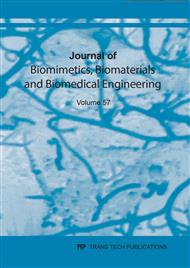[1]
CITEVE. A Indústria Têxtil e do Vestuário: Roadmap para a Inovação 2012-2020. (2012).
Google Scholar
[2]
Kamalha, S., Zeng, E., Mwasiagi, Y., & Kyatuheire, J. I.. The comfort dimension; a review of perception in clothing. Journal of Sensory Studies, 2013. 28(6), 423–444. Doi: https://doi.org/10.1111/joss.12070.
DOI: 10.1111/joss.12070
Google Scholar
[3]
Liu, Z. A survey of outdoor sportswear requirement for Chinese consumers. Adv. Mater. Res. 2012, 479–481, 676–679.
DOI: 10.4028/www.scientific.net/amr.479-481.676
Google Scholar
[4]
Zhang, Z., Li, Y., Gong, C. and Wu, H. Casual wear product attributes: A Chinese consumers' perspective. JFMM 6, 2002, p.53–62.
DOI: 10.1108/13612020210422464
Google Scholar
[5]
R. Van Der Linden, J. C. D. S.; Guimarães, L. B. D. M.; Tabasnik, Conforto e desconforto são constructos opostos?,, in 3o Congresso Internacional de Pesquisa em Design, 2005, p.1–8.
Google Scholar
[6]
K. S. Cho, Redesigning hospital gown to enhance end users' satisfaction,, Fam. Consum. Sci. Res. J., vol. 34, p.332–349, 2006, doi: https://doi.org/10.1177/1077727X06286570.
Google Scholar
[7]
Pontrelli, F.J, Partial analysis of comfort's gestalt. In Clothing Comfort: Interaction of Thermal, Ventilation, Construction, and Assessment Factors ( N.R.S. Hollies and R.F. Goldman , eds.), Ann Arbor Science Publishers, Ann Arbor, MI. 1977, p.71–80.
DOI: 10.1002/pol.1978.130160509
Google Scholar
[8]
Kaplan, S. and Okur, A, The meaning and importance of clothing comfort: A case study for Turkey. J. Sensory Studies. 23, 2008, 688–706.
DOI: 10.1111/j.1745-459x.2008.00180.x
Google Scholar
[9]
Kaplan, S. and Okur, A, Determination of coolness and dampness sensations created by fabrics by forearm test and fabric measurements. J. Sensory Studies 24, 2009, 479–497.
DOI: 10.1111/j.1745-459x.2009.00222.x
Google Scholar
[10]
Lee, H., & Jin, H, Conceptual design framework as a model for wheelchair users' sportswear comfort. Fashion and Textiles, 2019, 6(1), 1-13.
DOI: 10.1186/s40691-019-0179-z
Google Scholar
[11]
Almeida, M. D., Broega, A. C., & Moura, M. The physiological aspects of senescence: Comfort and relationship with the clothing. In Reverse Design: A Current Scientific Vision From the International Fashion and Design Congress. 2018, (p.263). CRC Press.
DOI: 10.1201/9780429428210-33
Google Scholar
[12]
McRoberts, L. B., Black, C. M., & Cloud, R. M. Evaluation of a prototype soft-structured thoracic posture support garment. Clothing and Textiles Research Journal.2015. . https ://doi.org/10.1177/08873 02X15 62257 1.
DOI: 10.1177/0887302x15622571
Google Scholar
[13]
Liu, R., & Little, T.. The 5Ps model to optimize compression athletic wear comfort in sports. Journal of Fiber Bioengineering and Informatics, 2009, 2(1), 41–52.
DOI: 10.3993/jfbi06200907
Google Scholar
[14]
Abreu, Isabel, Patrícia Ribeiro, and Maria José Abreu. The issue of thermal comfort of medical clothing in the operating room., Dyna 84.200 (2017): 234-239.
DOI: 10.15446/dyna.v84n200.62157
Google Scholar
[15]
Braga, Iara, Maria José Abreu, and M. Oliveira. The importance of a comparative thermophysiological study in female jeans., IOP Conference Series: Materials Science and Engineering. Vol. 459. No. 1. IOP Publishing, (2018).
DOI: 10.1088/1757-899x/459/1/012034
Google Scholar
[16]
Reis, Benilde, et al. Design of Fashionable and Functional Tri-Laminated Wool Fabrics for Leisurewear Considering Comfort., International Conference on Applied Human Factors and Ergonomics. Springer, Cham, (2021).
Google Scholar
[17]
Harlin, Ali, Kirsi Jussila, and Elina Ilen. Sports textiles and comfort aspects., High performance technical textiles (2020): 37-67.
DOI: 10.1002/9781119325062.ch3
Google Scholar
[18]
Information on https://www.wgsn.com/fashion/search?query=functional%20future.
Google Scholar
[19]
Reis, Benilde, et al. Usability Attributes for Fashion Design of Functional Wool Leisurewear., Meeting of Research in Music, Arts and Design. Springer, Cham, (2020).
DOI: 10.1007/978-3-030-55700-3_23
Google Scholar
[20]
Azevedo S, Pereira M, Ferreira J, Miguel R, Factors that influence the clothes' buying decision. In: Vignali G (ed) Fashion marketing & theory. GSE Research, UK, 2009, p.55–63.
DOI: 10.5848/apbj.0105.00005
Google Scholar
[21]
Information on https://www.wgsn.com/fashion/search?query=activewear%20trends%20.
Google Scholar
[22]
Information on https://www.wgsn.com/fashion/search?query=leisure+wear.
Google Scholar
[23]
A. Mukhopadhyay and V. K. Midha, Waterproof breathable fabrics,, in Handbook of technical textiles, Second., A. R. Horrocks and S. C. Anand, Eds. (2000).
DOI: 10.1016/b978-1-78242-465-9.00002-1
Google Scholar
[24]
G. R. Lomax, Breathable polyurethane membranes for textile and related industries,, J. Mater. Chem., vol. 17, no. 27, p.2775–2784, 2007,.
DOI: 10.1039/b703447b
Google Scholar
[25]
N. Zagor, Matrix 2.0,, 2018. Accessed: Sep. 19, 2019. [Online]. Available:https://www.wgsn.com/content/board_viewer/#/78262/page/7.
Google Scholar
[26]
L. Kramar, Recent and Future Trends for High Performance Fabrics Providing Breathability and Waterproofness,, vol. 28, no. October 1998, p.106–115, (1999).
DOI: 10.1177/152808379802800203
Google Scholar
[27]
A. Mukhopadhyay and V. K. Midha, Waterproof breathable fabrics,, in Handbook of technical textiles, Second., A. R. Horrocks and S. C. Anand, Eds. (2000).
DOI: 10.1016/b978-1-78242-465-9.00002-1
Google Scholar
[28]
Y. J. Ren and J. E. Ruckman, Water Vapour Transfer in Wet Waterproof Breathable Fabrics,, J. Ind. Text., vol. 32, no. 3, p.165–175, 2003,.
DOI: 10.1177/1528083703032003002
Google Scholar
[29]
Zegna, Z Zegna TechmerinoTM Wash&Go," L,Editoriale, 2019. https://www.zegna.us/us-en/editorial/fabrics/wash-go-garments-care-instructions.html (accessed Sep. 18, 2019).
Google Scholar
[30]
REDA, The innovative CompAct3 spinning system renders the fabric able to enhance physical activity,, Style in movement, 2019. https://www.reda1865.com/row/style-in-movement (accessed Jul. 19, 2019).
Google Scholar
[31]
REDA, Reda Active features,, Active Thermoregulation, 2019. https://www.reda1865.com/row/active-thermoregulation (accessed Jul. 19, 2019).
Google Scholar


